2. 农业部作物高效用水科学观测实验站 原阳 453514
2. Yuanyang Experimental Station of Crop Water Use, Ministry of Agriculture, Yuanyang 453514, China
免耕、深松与表土作业等土壤耕作措施可改善土壤结构[1-2],降低坡耕旱地水土流失,增强土壤微生物活性,降低作物干旱胁迫的伤害[3]。同时,可提高土壤肥力[4]和土壤孔隙度,降低土壤容重,促进作物生长[5]。秸秆还田+免耕可增加表层土壤的通气孔隙,降低其无效孔隙,改善土壤结构,提高土壤持水性能,增加土壤水分库容[6]。少耕或免耕有利于接纳降雨和水分储存,促进作物产量与水分利用率的提高[7-9]。免耕+秸秆覆盖能有效保持土壤剖面水分含量,减少土壤蒸发量[10],提高土壤的饱和导水率[11]。于同艳等[12]研究表明,免耕虽不利于水分入渗,但可有效保持土壤中的水分。杨永辉等[13]研究表明,连续2年免耕可改善土壤结构,降低土壤容重,改善土壤孔隙状况。深松能够打破土壤犁底层,改善土壤孔隙,促进土壤蓄水保墒,有利于作物根系利用深层土壤水[14],且深松能够显著提高>0.25 mm水稳性团聚体含量,有效提高土壤的储水量[15]。深松+地面覆盖可改善土壤团粒结构,提高土壤剖面的水分状况[16]。免耕与深松轮作能显著提高土体的蓄水量[17-18]。以往的研究多偏重于免耕覆盖或深松覆盖或二者轮作,且研究深度为犁底层以上的土壤,对于深层土壤的影响,以及长期单独深松或免耕对土壤剖面物理特征、入渗过程及有机碳分布特征及其作用深度等影响如何目前尚鲜见报道,需要深入研究,以阐明长期深松和免耕对土壤的作用机理。
笔者对长期深松和免耕条件下0~100 cm土层的土壤结构、水分入渗过程与蒸发特征、有机碳分布及相互关系进行了研究,为阐明在小麦(Triticum aestivum)、玉米(Zea mays)轮作过程中,长期进行深松和免耕对土壤剖面物理特征的改善及其作用机理提供科学依据。
1 材料与方法 1.1 研究区概况试验设置在河南省禹州试验基地(113°03′~ 113°39′E,33°59′~34°24′N,海拔116.1 m)进行,多年平均降水量674.9 mm,其中60%以上降雨集中在夏季; 土壤类型为褐土。研究区地势平坦,耕层土壤有机质含量12.3 g·kg-1、全氮含量0.80 g·kg-1、水解氮含量47.82 mg·kg-1、速效磷含量6.66 mg·kg-1、速效钾含量114.8 mg·kg-1。研究区为小麦-玉米轮作区。2014年度小麦品种为‘周麦22’,玉米品种为‘郑单958’。土壤机械组成为: 砂粒(2~0.02 mm)占59.1%,粉粒(0.02~0.002 mm)占22.5%,黏粒(<0.002 mm)占18.4%。
1.2 试验设计长期定位试验于2006年10月中旬小麦播种时开始,耕作措施在每年小麦播种时实施,玉米均为免耕播种。试验共设置3个处理: 常规耕作(耕作深度为15 cm)、免耕、深松(深度30 cm),试验小区未进行秸秆还田。肥料采用N25P15K15复合型肥料,在小麦播种时一次性底施。在小麦播种前将肥料均匀撒于小区内,然后进行常规耕作和深松; 免耕的施肥方式为小麦、玉米播种后点施。
于2014年玉米收获后(10月12日)从定位试验每个处理的3个重复小区中间位置采用原状土柱采集器采集0~100 cm原状土柱,测定土壤入渗过程。即将有机玻璃管放入采集器中,用铁锤于采集器上方进行竖直敲击,待采集器进入土中深度110 cm时,将采集器拔出,并从采集器的下方取出采集器内的有机玻璃管。同时在采集原状土柱的旁边挖剖面,并分层采集(0~10 cm、10~20 cm、…、90~100 cm)环刀样(测定饱和导水率)、原状土(测定团粒结构)及混合土壤样品(测定土壤有机碳含量)。每个处理取3个重复带回室内进行分析。
1.3 测定项目与方法1) 土壤饱和导水率采用恒定水头法[19]测定,水稳性团聚体采用维诺夫法[20](湿筛法)分级测定,土壤有机碳采用改进的外加热重铬酸钾氧化法[21]测定。
2) 土壤入渗过程测定。将田间采集的原状土柱(土柱长110 cm,直径20 cm,壁厚1 cm)带到室内,放置,待土柱含水量为8%~10%左右(表 1),进行土柱水分入渗过程的观测。观测前,对土柱进行称重并记录其初始重量。在土柱(透明有机玻璃)侧面,平行于土柱方向粘贴带有刻度的坐标纸,从上至下标注土柱的深度,精确度为1 mm。采用马氏瓶在土柱上方(土柱上方留有10 cm高度空间,以接纳供水)进行恒定水头的供水。调节马氏瓶高度,土柱上方的水层厚度控制在5 cm左右。从土柱供水时开始计时,并观测土柱剖面的水分入渗距离,每个土柱上观测3组数据(土柱侧面等间距竖直粘贴3条坐标纸,以获得3组数据,计算其平均值作为观测值,最小刻度为mm),每个处理3个土柱共9组数据计算平均值。开始观测时每分钟观测1次土柱水分入渗距离,同时观测马氏瓶中水层下降高度。待入渗距离推进缓慢时,延长观测记录数据时间。待水分入渗至土柱底层时,测量渗流出来的水分,当渗流水量恒定时(土柱含水量达到饱和,见表 1),停止对土柱进行供水,并用胶带封住土柱底部,防止水分从土柱底部流出。观测结束后计算土柱累积入渗量、入渗速率。并采用精确度为1 g的电子天平对土柱进行称重,获得土柱饱和后的总重量。每隔1 d对土柱称重1次,观测其累计蒸发量,观测前后土柱含水量见表 1。
| 表1 不同土柱初始含水量、饱和含水量及蒸发试验结束后的含水量 Table 1 Initial water content,saturated water content and water content after the end of evaporation experiment % |
土柱入渗速率计算方法如下:
| $V=\frac{10\times {{Q}_{n}}}{{{t}_{n}}\times S}\begin{matrix} \times 60 \\ \end{matrix}$ | (1) |
式中: V为渗透速率,mm·min-1; Qn为n次马氏瓶中进入土柱的水量,mL,即cm3; tn为每次渗透所间隔时间,min; S为土柱横截面积,cm2; 10为由cm换算成mm所乘倍数; 60为将渗透速率(V)单位mm·min-1转换为mm·h-1。
1.4 数据处理不同结果数值均为3次重复的算术平均值,且所得数据采用Microsoft Excel及SPSS软件进行处理。
2 结果与分析 2.1 长期不同耕作措施下水分入渗规律分析 2.1.1 水分运移规律分析不同耕作措施对水分在土壤剖面中的运移规律各异(图 1)。由于3个处理的土柱初始含水量较低(表 1),水分入渗较为迅速,3种耕作方式下,在很短时间内到达35 cm处,其中以深松处理最快。之后土壤水分在土壤剖面上的入渗湿润峰行进减缓,且各土柱之间差异显著(P<0.01),常规耕作处理到达相同距离的时间明显增加。而深松处理的水分运移仍较快,在不到3 h入渗到土柱底部;免耕处理水分运移到底部的时间是深松处理的2倍,常规耕作则超过24 h。说明深松打破了犁底层,使得土壤上下层更加通透(运移曲线上下平直),更利于水分就地入渗; 而常规耕作因为犁底层的阻隔,入渗能力明显降低; 免耕虽也受到犁底层的影响,但由于其改善了表层土壤结构,进而入渗能力大于常规耕作。
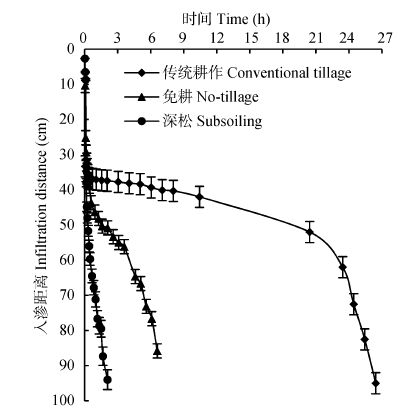
|
图 1 长期不同耕作措施对土壤入渗特征的影响 Figure 1 Soil water infiltration characteristics under different long-term tillage measures |
不同耕作措施土壤的初始入渗量基本相当,但随时间的推移,差异逐渐增大(图 2),且达极显著水平(P<0.01)。在土壤水分进入土壤3 h后,深松处理的土柱土壤到达饱和。常规耕作处理达到土壤饱和含水量的时间远大于其他处理,且其累计入渗量均小于其他处理。在相同时间内,累计入渗量大小为: 深松>免耕>常规耕作(P<0.01)。说明深松后土壤蓄水容量显著提高,免耕的扩蓄增容效果也十分明显,分别较常规耕作提高27.3%和22.8%。
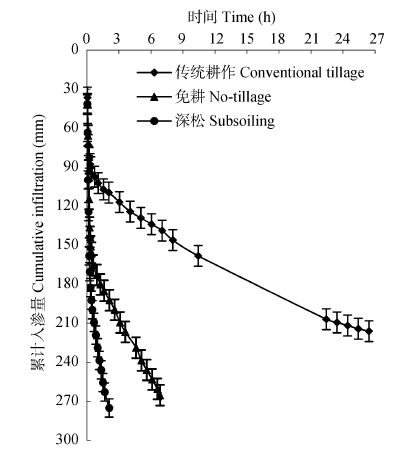
|
图 2 长期不同耕作措施对土壤累计入渗量的影响 Figure 2 Soil cumulative infiltrations under different long-term tillage measures |
随时间的推移,土壤入渗速率逐渐降低。在整个入渗过程中,以深松处理的入渗速率最高,其次为免耕处理,常规耕作处理最低(P<0.05),尤其在0~2.0 h间差异较大(P<0.01)(图 3)。随时间的推移,各处理的入渗速率降低幅度逐渐减小,最终趋于恒定值,且深松与免耕仍高于常规耕作(P<0.05)。

|
图 3 长期不同耕作措施对土壤入渗速率的影响 Figure 3 Soil infiltration rates under different long-term tillage measures |
随时间的推移,不同耕作处理的土壤累计蒸发量逐渐增大,且差异显著(图 4)(P<0.01)。虽然常规耕作处理饱和时的含水率低于其他处理(表 1),但其初始及随后的蒸发量仍明显高于其他处理(P<0.01)。而免耕处理的蒸发量均显著低于其他处理(P<0.01),其次为深松处理。说明实施深松和免耕耕作能够有效减少土壤的无效蒸发量。
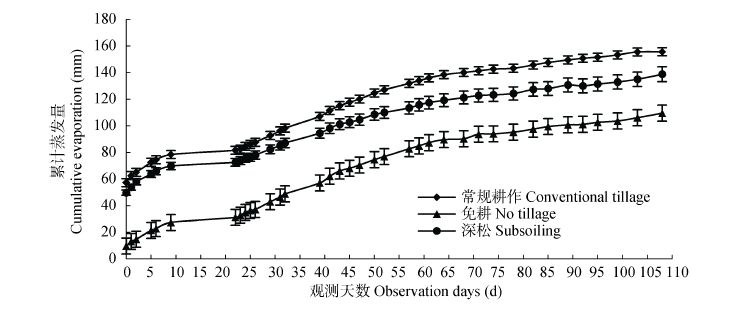
|
图 4 长期不同耕作措施对土壤蒸发过程的影响 Figure 4 Soil evaporations under different long-term tillage measures |
从图 5中可知,20~30 cm土层的土壤饱和导水率最低,而10~20 cm土层最高(免耕处理除外),随土层的加深,土壤饱和导水率趋于平缓。在0~10 cm土层,土壤饱和导水率表现为: 免耕>深松>常规耕作(P< 0.05); 在10~20 cm土层,深松处理明显高于其他处理(P<0.05),这可能是深松后作物根系和蚯蚓活动频繁所致; 在20~30 cm土层,各处理之间差异较小(P>0.05),但仍以深松处理的饱和导水率最高; 30~ 40 cm土层,各处理的土壤饱和导水率均增大,其中仍以深松处理最高,其次为免耕处理,常规耕作最低(P<0.05)。随土层的进一步加深,各处理的土壤饱和导水率趋于稳定,但整体来看,60 cm以下土层,免耕和常规耕作处理土壤饱和导水率较低,而深松处理土壤饱和导水率较高(P<0.05)。说明经过长期免耕和深松措施后,土壤剖面导水性能提高,尤其是20~30 cm以上土层效果更为显著,深松处理效果最佳。
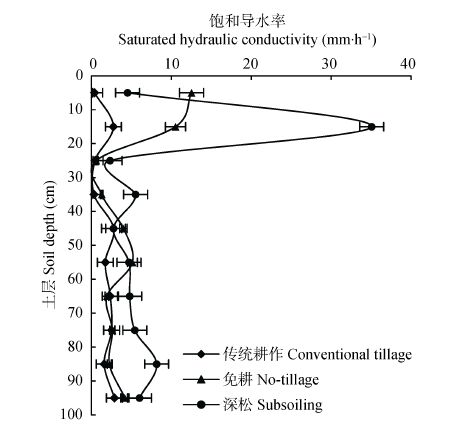
|
图 5 长期不同耕作措施对剖面土壤饱和导水率的影响 Figure 5 Soil saturated hydraulic conductivities under different long-term tillage measures |
图 6显示,不同耕作处理土壤有机碳含量在40cm以上土层含量丰富,特别是20cm以上的表层,40~ 70 cm为含量过渡层,70 cm以下为稳定层,总体随深度增加而衰减。在60 cm以上土层,均以免耕处理的土壤有机碳含量最高,其次为深松处理,常规耕作最低。而70~100 cm土层土壤有机碳变化较平缓,其有机碳含量为2~4 g×kg-1。在80~100 cm土层,常规耕作处理的土壤有机碳均高于免耕和深松处理。说明经过长期免耕和深松促进了根系的生长和土壤生物的活动,土体有机碳得到改善的作用深度达60 cm以上。
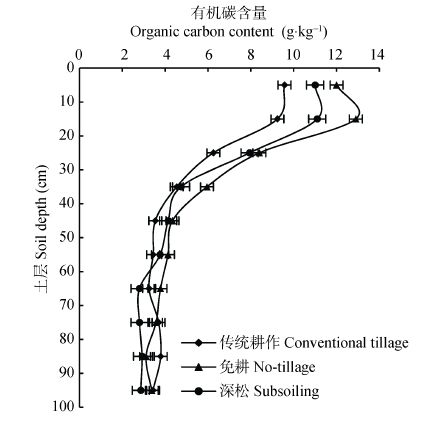
|
图 6 长期不同耕作措施对0~100 cm土层土壤有机碳分布含量的影响 Figure 6 Distribution characteristics of soil organic carbon in 0-100 cm soil layer under different long-term tillage measures |
>0.25 mm水稳性团聚体含量表征了土壤结构的稳定性。从图 7可知,随土层的加深,>0.25 mm水稳性团聚体含量表现为先增加再显著降低的趋势。在0~10cm和10~20 cm土层,>0.25 mm水稳性团聚体含量表现为: 深松>免耕>常规耕作(P<0.05)。在0~40cm和80~100cm土层,均以深松处理>0.25 mm水稳性团聚体含量最高(P<0.05)。常规耕作处理除70~90 cm土层>0.25 mm水稳性团聚体含量较高外,其他土层均最低。说明不同耕作措施改善了土壤剖面的团粒结构,提高了土壤结构的稳定性,尤其是60 cm以上土层。
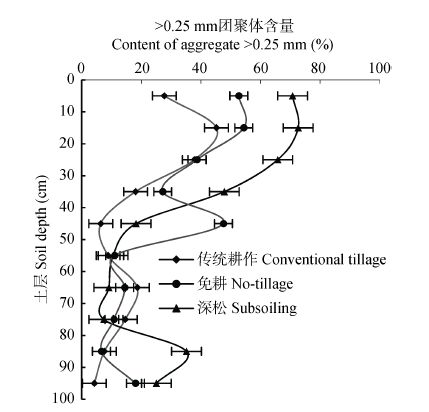
|
图 7 长期不同耕作措施对0~100 cm土层>0.25 mm团聚体含量分布特征的影响 Figure 7 Distribution characteristics of > 0.25mm aggregate content in 0-100 cm soil layer under different long-term tillage measures |
>0.25 mm水稳性团聚体含量与土壤有机碳含量及土壤饱和导水率、土壤有机碳含量与土壤饱和导水率均表现为二次曲线关系(图 8),且相关性均为极显著水平(P<0.01)。随土壤有机碳含量的增加,>0.25 mm水稳性团聚体含量增加,土壤饱和导水率则表现为先降低再增加的趋势; 随着>0.25 mm水稳性团聚体含量增加到一定阀值(占总团聚体30%)后继续增加,饱和导水率呈逐渐增加趋势。说明合理的耕作措施能够提高土壤中的有机碳,从而改善土壤结构,促进了土壤渗透能力的提高。
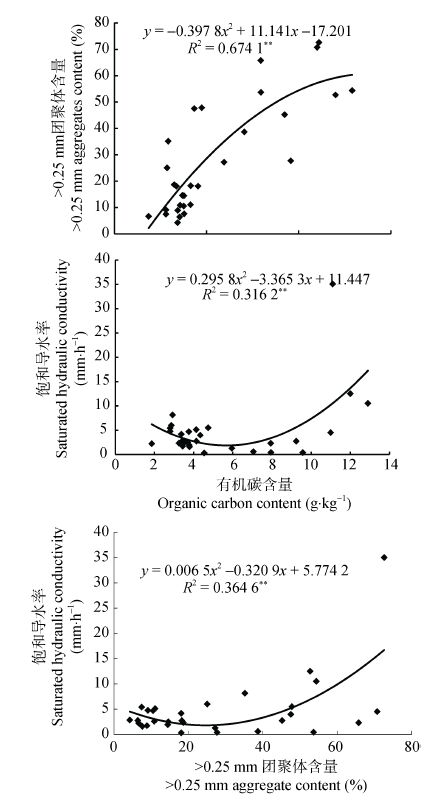
|
图 8 >0.25 mm团聚体含量、饱和导水率及土壤有机碳相关性分析 Figure 8 Correlation analysis among between >0.25mm soil aggregate content,saturated hydraulic conductivity and soil organic carbon content |
深松、免耕可促进土壤有机质含量提高,改善土壤结构[22, 24-25],提高土壤结构的稳定性,改善土壤的水分环境[26]。进行长期深松和免耕会对剖面土壤的物理性质产生重要影响。本研究发现,在35 cm以上土层,水分运移较快,而以深松处理最快。但在35 cm以下,常规耕作处理水分运移速度明显减缓,深松处理水分运移较快。最终水分从土柱顶部入渗到底层的时间为: 常规耕作>免耕>深松。在0~2.0 h时间段各处理的入渗速率差异较大,且以深松处理时间段各处理的入渗速率差异较大,且以深松处理最大,其次为免耕处理,常规耕作处理最低。随时间的推移,各处理的入渗速率逐渐降低,并趋于恒定,且仍以深松处理最高,其次为免耕处理。土壤饱和导水率反映了不同土层之间土壤结构的差异,而水分在土壤中的蓄存能力反映了不同措施对土壤结构的改善能力。以往的研究多偏重于耕层,对于土壤剖面不同土层而言,本研究发现,在0~10 cm和50~ 60 cm土层,免耕处理更利于土壤饱和导水率的提高,其次为深松处理,常规耕作处理最低; 而在10~ 50 cm和60~100 cm土层,深松处理最高。说明深松打破了犁底层,改善了土壤孔隙状况[14],增加了土壤的通透性[27],促进了水分就地入渗,并向更深土层的运移[28],提高土体的含水量[16]。而免耕条件下形成的良好土体结构,使其有效毛细管增多,且孔管连续不间断,从而有利于水分的快速移动[29],改善土体的入渗能力。这与高建华等[30]和于同艳等[12]研究结果相反,而与Dao[31]和Hati等[32]研究结果一致,这可能与免耕时间[33]、土壤类型、种植制度等有关,需要进一步研究。此外,实施免耕和深松能够提高土壤的累积入渗量,增加土壤水分库容量,且降低了土壤的无效蒸发,各处理中,深松更利于水分入渗,而免耕更利于水分的保持。而有研究表明[18],深松1年后进行免耕也能促进土壤蓄水保墒,而在长期深松后进行免耕的结果如何,需要进一步研究。
土壤入渗过程及蓄水能力与土壤结构[34]和有机质含量[35]紧密相关,可通过提高土壤有机质来改善土壤结构,进而调节水分在土壤中的转化、保持与供应,从而提高土壤的生产与生态功能。本研究发现,土壤有机碳含量随土层的加深而先增加(10~20 cm)再降低,到70 cm以下土层土壤有机碳趋于稳定。在60 cm土层以上,均以免耕处理的土壤有机碳含量最高,其次为深松处理,常规耕作处理最低。说明长期免耕和深松有利于水分的保持,促进了作物根系的生长和土壤生物的活动,而作物根系残留物或根系分泌物和土壤生物粪便又促进了土壤有机碳含量提高,改善了土壤结构。因此,>0.25 mm水稳性团聚体含量随土层的加深也表现为先增加(10~20 cm)再降低的趋势。除60~80 cm土层外,均以深松处理>0.25mm水稳性团聚体含量最高,其次为免耕处理,特别在60cm以上土层,效果更为显著。陈强等[36]的研究也得到了相同结论,而高建华等[30]研究表明免耕对土壤结构的改良并不明显,这可能与耕作时间或土壤类型有关,需要进一步研究。此外,相关研究仅基于表层土壤,而对于深层土壤的影响研究涉及较少。
综上,合理的长期耕作措施能够提高土壤剖面中的有机碳含量,从而改善土体土壤结构,促进土体土壤渗透能力和蓄水保墒能力的提高。而深松更利于水分就地入渗,免耕更利于有机碳的提升和水分的储存。但本研究为实行长期定位试验8年后的结果,而对于更长年限的免耕、深松或持续免耕后进行深松及持续深松后进行免耕等对土壤剖面物理特性的影响差异及程度如何,有待下一步研究。
 2017, Vol. 25
2017, Vol. 25



